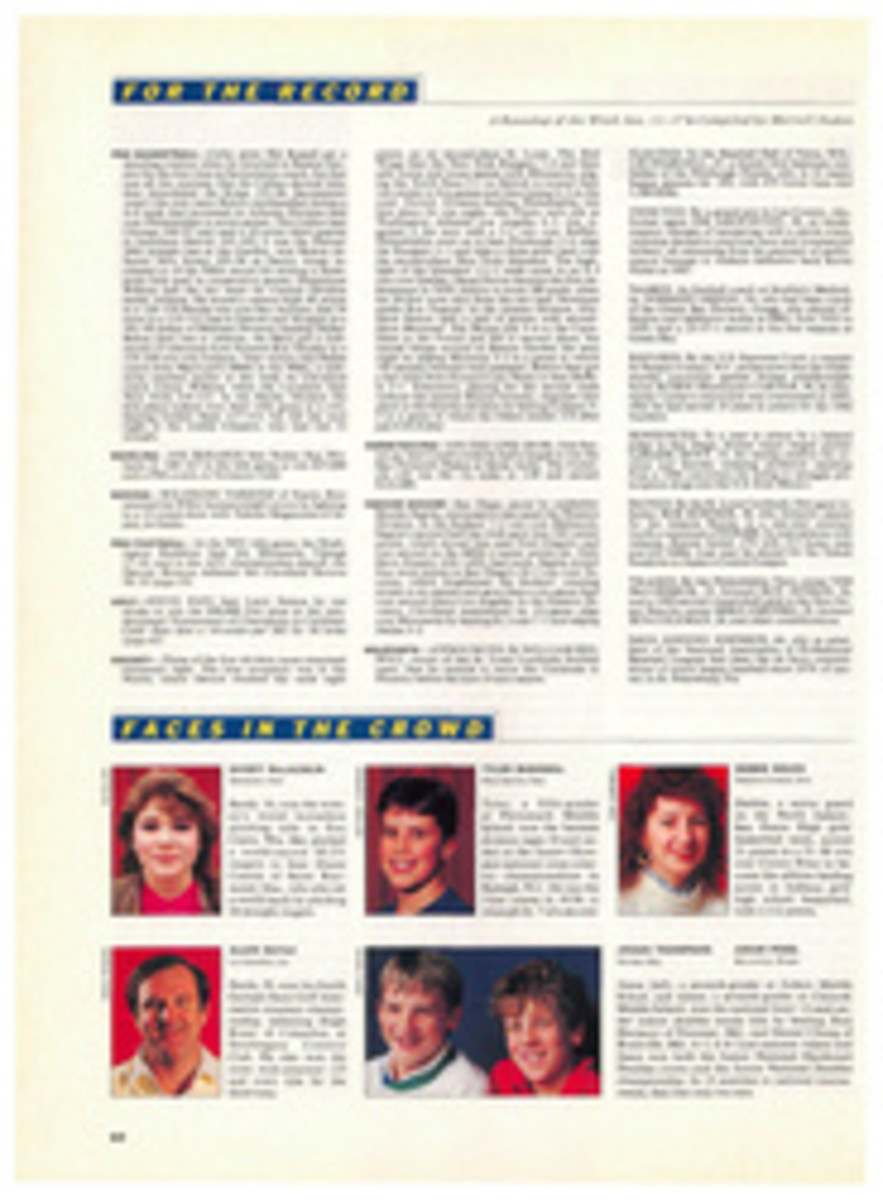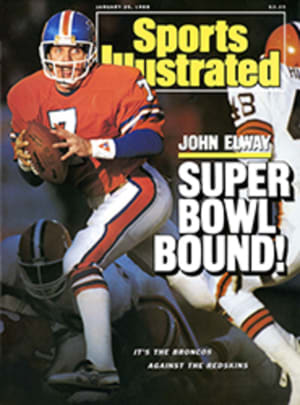
SCORING IN HIGHEST STYLE
If it plays in Peoria, says Madison Avenue, it will play anywhere. So all you ad execs and marketing veeps at Frito-Lay and Coca-Cola and M & M/Mars, take note: Hersey Hawkins, who does play in Peoria, for Bradley, brought along a small convenience store's worth of your products on the Braves' bus trip last week from Peoria to Terre Haute, Ind., for a game with Indiana State. It was much-needed extra fuel for the extra miles he's logging in coach Stan Albeck's NBA-style odometer offense—an offense to which Hawkins contributes 37.4 points a game.
If points were sales figures, Hawkins, a 6'3" senior guard, would be sitting atop the Fortune 500 instead of the NCAA scoring charts, which he has dominated all season. At the end of last week he led No. 2 scorer Daren Queenan of Lehigh by nearly eight points a game and had a shot at becoming the first collegian to average better than 40 a game since Johnny Neumann scored 40.1 for Mississippi in 1971.
Hersey (rhymes with "have mercy") opened the season with 42 against New Orleans and 44 against Colorado. Three games later, against UC Irvine, Hawkins drew his third foul midway into the first half. He sat out from then until the intermission, but still finished the game with a career-high and school-record 51 points in Bradley's 139-119 victory. "It was an entertaining game to watch," Hawk said afterward. "I know, because I watched too much of it."
Everyone calls him Hawk, except for a boyhood friend back in Chicago who knows him as Hearse. The two nicknames get Hawkins's game just about right: It's marked by sudden flights, but with consistently grave results for opponents. In a typical game he has three steals, four assists and seven rebounds, and his 37 points break down to, oh, a dozen field goals, including three three-pointers, and 10 free throws.
The choreography for all this is Al-beck's. Bradley runs a turnout fast-break offense, the same set Albeck used as coach of the San Antonio Spurs, New Jersey Nets, Cleveland Cavaliers and Chicago Bulls to spring George (Ice) Gervin, Otis Birdsong and Michael Jordan for impressive NBA integers. Bradley's frontcourt men sprint down the floor and set screens on both sides of the foul lane. From his spot at the free throw line, Hawkins runs down the middle of the lane and "turns out" one way or the other, hoping to leave his defender pinned against a screen and free himself to catch a pass and shoot. If the defender fights through the screen or tries to cheat around it or the screener's man picks Hawkins up, Hawkins merely circles back and starts again. "If I don't have the shot, that's when the running really starts," he says. "I keep going until I get open."
In the process Hawkins runs a gantlet of clutching and grabbing and elbowing—and never changes his mien. Says Bradley forward-center Donald Powell, Hawkins's roommate, "Hawk knows a lot of that is to entice him into throwing a punch and getting thrown out of the game." Adds Albeck, "When he does frown—it'll start right above his eyes—you know he's serious."
The more the defenders grab, the more Hawkins runs. Even in practice. "There are times I go straight to bed after three hours of guarding Hawk in practice," says teammate Paul Wilson. "He never, ever gets tired." Last season Hawkins did try stealing a breather now and then. But, he says, "if I stopped, everyone else stopped, and our whole offense would be thrown off. This season I'm in much better condition. I'll always have better second halves than first halves because defenders start to tire out."
He scored five points in the first half against Dayton and ended up with 36. Evansville held him to seven in the first half, only to see him finish with 32. Last week against Indiana State, Hawkins had another desultory first half, shooting one for seven, but midway through the second he scored 10 straight points to sew up the game for Bradley. Said Milwaukee Bucks player personnel director Bob Zuffelato, on hand to observe the Hawk, "He had an off-night but still did everything a pro has to do. He comes off the screens, has that quick release and makes the big shots."
Against UNC Charlotte on Jan. 6, Hawkins scored 16 points in the first half and had another 33 in the final 20 minutes. He could have broken 50 again, but passed up a breakaway slam as the clock ticked down to let Braves center Luke Jackson do the honors. "It was time to reward him for setting all those picks," says Hawkins.
Despite all that scoring, Albeck still doesn't think Hawkins is sufficiently aggressive when he has the ball. "I've got to beg the guy to shoot," says Albeck, who marvels at Hawk's production considering that he averages only 23 shots a game. In the game against UNCC, teammate Jerry Thomas ripped Hawkins for throwing him a pass. Says Hawkins, "It was the first time anyone ever told me, 'I don't care if I'm in the open! Shoot the ball!' "
Today's industrious Hawkins contrasts starkly with the indifferent and indolent ninth-grader who quit the team at Chicago's Westinghouse High because he didn't want to rise for 6 a.m. practices. Only a double-team by Hawkins's parents, Hersey Sr. and Laura, prevented him from sleeping his career away. In three seasons of playing center he racked up nice enough numbers but attracted attention only from, he says, "a whole bunch of really small schools."
He chose relatively big-time Bradley, but two years later, in the summer of 1986, the Braves were put on probation (banned from TV and postseason play in '86-87 for recruiting violations, involving neither Hawkins nor any of his teammates), and coach Dick Versace was out. As Bradley looked for a replacement, Hawkins all but decided to transfer to Villanova. "When I came in, he was within an eyelash of being gone," says Albeck, who appealed to Hawkins's NBA ambitions in persuading him to remain in Peoria. "I told him about Ice and Otis and Michael. I promised him we could make him an even better player than he already was." Hawkins stayed, and filed a lawsuit against the NCAA charging that the probation jeopardized Hawkins's potential value in the 1988 NBA draft.
The case was ultimately dropped, but his draft value hasn't. Albeck sees Hawkins being taken among the first 10 picks in the June draft. The Hawk's similarities to 6'4" Sidney Moncrief, Albeck says, are remarkable: the post-up ability, the long legs, the even temper, the unselfishness. And the stamina. "If it gets me to the NBA," says the Hawk, "then I'll keep running."
PHOTO
DAVID E. KLUTHO
PHOTO
JOHN BIEVER
His tireless running and quick release make Hawkins a threat to score a point a minute.

